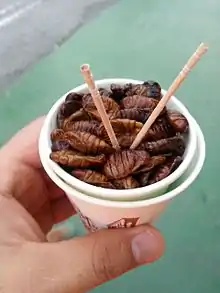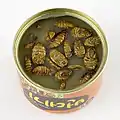Beondegi
Beondegi (번데기), literally "pupa", is a Korean insect-based street food made with silkworm pupae.[1]
 | |
| Course | Street food |
|---|---|
| Place of origin | Korea |
| Associated cuisine | Korean cuisine |
| Main ingredients | Silkworm pupae |
| Similar dishes | Nhộng tằm |
| Korean name | |
| Hangul | 번데기 |
|---|---|
| Revised Romanization | beondegi |
| McCune–Reischauer | pŏndegi |
| IPA | [pʌn.de.ɡi] |
The boiled or steamed snack food is served in paper cups with toothpick skewers.[2][3] Its aroma has been described as "nutty, shrimp-like, and a bit like canned corn" and the canned type smells very much "like tire rubber", while the texture is firm and chewy.[4]
Beondegi is also served in soup form as beondegi-tang. This soup is flavoured with soy sauce, chili, garlic, green onions and red pepper powder. It is typically served as an anju (food consumed with alcohol) at pubs.[4]
Canned beondegi and beondegi-tang can also be found in supermarkets and convenience stores.[3][4]
History
Although sericulture in Korea dates back 4,000 years, consumption of silkworm pupae (a byproduct of this industry) is relatively recent. Beondegi has been eaten in silk farming villages since at least the 1920s. Widespread consumption began after the Korean War, when the government heavily promoted the silk industry. Silkworm pupae were a protein source during the poverty of the time.[4]
Gallery
 Beondegi sold by a street vendor
Beondegi sold by a street vendor Canned beondegi
Canned beondegi
References
- Pettid, Michael J. (2008). Korean Cuisine: An Illustrated History. London: Reaktion Books. p. 173. ISBN 978-1-86189-348-2.
- Kraig, Bruce; Sen, Colleen Taylor, eds. (2013). Street Food around the World: An Encyclopedia of Food and Culture. Santa Barbara, CA: ABC-CLIO. p. 320. ISBN 978-1-59884-954-7.
- "Beondegi | Traditional Insect Dish From South Korea | TasteAtlas". www.tasteatlas.com. Retrieved 2022-08-24.
- "Salty Silkworm Pupae Are the One Street Food You Shouldn't Miss in South Korea". Matador Network. Retrieved 2022-08-24.
